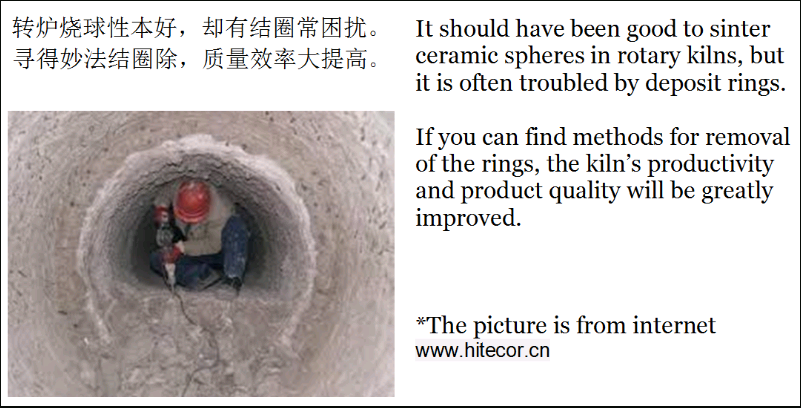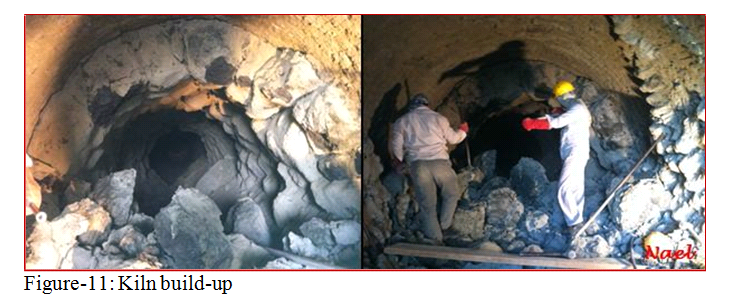Contents
click here to Download the Most Important 13 Books in Cement Industry
click here to Download the Most Important 13 Books in Cement Industry
Every year cement industry loses millions of dollars in unexpected kiln shutdowns caused by rings build–up inside the kiln. What are the reasons behind formation such type of build–up?
By: Nael Shabana qatar.cement@yahoo.com

Kiln Build up (figure-11) or ring formation mechanism can be divided depend on formation chemistry or formation location as the following:
a). Rings with regard to formation chemistry:
- Sulphur Rings: Sulphur-induced rings are formed when the molal sulfur to alkali ratio in the system is more than 1.2. In such cases, there is a considerable amount of free SO3 circulating in the kiln. At a certain concentration level in the kiln gas, sulfation of the free lime occurs with anhydrite formation (CaSO4). If the kiln is burning under slightly reducing conditions, more volatile and lower melting sulfur salts may form, therefore increasing the severity of the problem. The salts, in molten state, coat the traveling clinker dust, forcing it to stick to the kiln wall in the form of rings. Sometimes the chemical analysis of such rings does not indicate high sulfur concentrations, proving that even a small amount of free sulfur is sufficient to cause rings.
- Spurrite Rings: Carbonate or spurrite rings are formed through CO2 desorption into the freshly formed free lime, or even through belite re- carbonation. These rings are hard, layered, and exhibit the same chemistry as regular clinker. Spurrite is a form of carbonated belite. When the carbonate in the spurrite is replaced with sulfur the new mineral is called sulfated spurrite. Spurrite rings form whenever the partial pressure of CO2 above the bed of material is high enough to invert the calcining reaction.
- Alkali Rings: The third type of ring occurs whenever the sulfur-to-alkali molal ratio is less than 0.83, usually in kilns with heavy chlorine loads. In such cases, low-melting potassium salts provide the binder for clinker dust travelling up the kiln. Through a “freeze-and-thaw” mechanism, these rings can assume massive proportions. Alkali rings are far less common than other types because sulfur and carbonates usually are in excess relative to potassium.

b). Rings with regard to formation location:
- Intermediate Rings: Intermediate rings are dense, hard and seldom fall off during kiln operation. They are elongated, being some 10-15 meters long and extending from 7 to 11 kiln diameters from the outlet. This ring is clinker-like in colour indicating it being composed of well burnt material. They have a layered structure, according the curvature of the kiln shell. Their chemical composition is very similar to that of clinker. No increase in concentration of S03 or alkalis takes place, and often the ring shows lower volatile element values than for clinker. The alite of the inner layers may decompose into belite and secondary free CaO, resulting from cooling down of the inner layers to a temperature lower than the stability temperature of the alite (1260°C).The mechanism of bonding is the freezing of the alumino-ferrite melt. The smallest clinker particles of 150-450 mm are carried back by the gas stream, fall down and are deposited on the kiln refractory lining, in a zone where temperatures of below 1250°C exist. The clinker dust particles freeze in place, and because the kiln charge is still fine, it does not possess sufficient abrasive action to remove the growing ring.
- Sinter Rings: These rings occur in the burning zone inlet, some 4-5 diameters from the kiln outlet. They are greyish-black in colour, hard and formed by small clinker nodules and clinker dust. Because of the presence of large pores and voids, no layered structure is formed. Their chemical composition is that of the clinker with no concentration of volatile elements. The alite of the inner layers may decompose into belite and secondary free CaO.
The bonding is created by the freezing of the clinker liquid phase. This phenomenon occurs especially in the burning zone inlet, where the liquid phase is just starting to form, at approximately 1250°C. Due to the rotation of the kiln, the material freezes with each kiln rotation and deposit of clinker particles having less than 1 mm diameter may reach a large thickness.
- Coal Ash Rings: In kilns fired with a high ash content coal, rings can form at 7-8.5 diameters from the kiln outlet. They are dense, with a layered structure and sometimes glassy in appearance and built up from particles some 150-250 mm in size. They are rather less dense and have larger pores and voids than intermediate rings. Their chemical and mineralogical composition is very similar to that of clinker. As the ring grows up and the temperature of the inner layers falls down the alite may decompose into belite and secondary free lime. The bonding mechanism is the freezing of molten coal ash particles and perhaps to a slight extent, the freezing of the clinker liquid phase. The molten coal ash droplets adhere to the kiln refractory lining in a zone where the temperature is high enough so that they are still partially sticky. When this layer passes under the kiln charge, one ach kiln rotation, a portion of the still very fine kiln charge adheres to it.